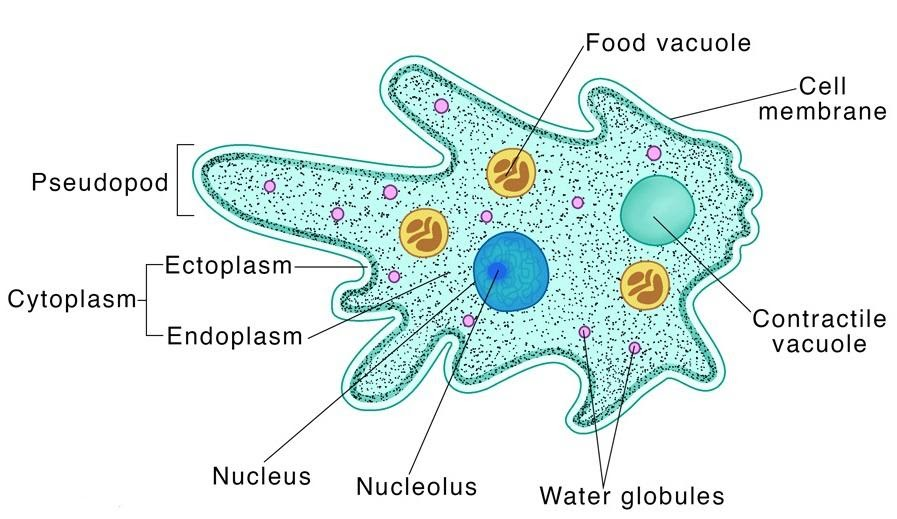
Passive food ingestion in Amoeba called?
Answer
399.9k+ views
Hint: Amoeba are unicellular protozoic organisms that are capable of catching prey/food by extending their finger like projections of protoplasm. They have the ability to alter their shape. They may be free living or parasitic. By extending your pseudopodia, you can change shape and move around, or 'false feet.' They are eukaryotic and possess certain characteristic features like that of eukaryotes.
Complete answer:
The term "amoeba", often called an amoeboid, is a type of cell or unicellular organism which has the ability to alter its shape, primarily by extending and retracting pseudopods. Amoebae do not form a single taxonomic group; instead, they are found in every major lineage of eukaryotic organisms. The cellular content and cytoplasm are enclosed within the cell membrane. Their DNA is packaged into a central cellular compartment called a nucleus.
Pseudopodia: Like our white blood cells, amoebae move using pseudopodia (or false feet). These are the short-lived outward projection of the cytoplasm and help amoebae to grip on a surface and move themselves forward. There are adhesions between an amoeba and the surface on which it moves, as physical molecular adhesions, which are constantly formed at the front end and broken at the back while moving. This movement, using pseudopodia, unites various amoebae and distinguishes them from other protists.
Amoebae also can use the pseudopodia to feed themselves. Phagocytosis is the process of absorbing solids. They have receptors on their cell surface that bind to bacteria or other food, which are gathered and taken into the amoeba by phagocytosis. The cell membrane that surrounds it pinches off to form an intra-cellular compartment called the vacuole and engulfs the organism. The process of engulfing liquid drops is called pinocytosis.

As mentioned earlier, amoeba may be parasitic. For ex. E. histolytica causes amoebic dysentery in humans. It is a parasite of the large intestine. One can acquire the infection through contaminated food and water. Housefly acts as the mechanical carriers and tends to transmit the parasite from faeces of infected persons to food and water.
Passive food ingestion in Amoeba is known as 'Import’, which is basically endocytosis (taking in of food on contact).
Note:
Unicellular organisms are often said to be immortal because they do not die and divide to form new organisms. And since the unicellular organisms grow by cell division, growth and reproduction in them are considered as synonyms.
Complete answer:
The term "amoeba", often called an amoeboid, is a type of cell or unicellular organism which has the ability to alter its shape, primarily by extending and retracting pseudopods. Amoebae do not form a single taxonomic group; instead, they are found in every major lineage of eukaryotic organisms. The cellular content and cytoplasm are enclosed within the cell membrane. Their DNA is packaged into a central cellular compartment called a nucleus.
Pseudopodia: Like our white blood cells, amoebae move using pseudopodia (or false feet). These are the short-lived outward projection of the cytoplasm and help amoebae to grip on a surface and move themselves forward. There are adhesions between an amoeba and the surface on which it moves, as physical molecular adhesions, which are constantly formed at the front end and broken at the back while moving. This movement, using pseudopodia, unites various amoebae and distinguishes them from other protists.
Amoebae also can use the pseudopodia to feed themselves. Phagocytosis is the process of absorbing solids. They have receptors on their cell surface that bind to bacteria or other food, which are gathered and taken into the amoeba by phagocytosis. The cell membrane that surrounds it pinches off to form an intra-cellular compartment called the vacuole and engulfs the organism. The process of engulfing liquid drops is called pinocytosis.

As mentioned earlier, amoeba may be parasitic. For ex. E. histolytica causes amoebic dysentery in humans. It is a parasite of the large intestine. One can acquire the infection through contaminated food and water. Housefly acts as the mechanical carriers and tends to transmit the parasite from faeces of infected persons to food and water.
Passive food ingestion in Amoeba is known as 'Import’, which is basically endocytosis (taking in of food on contact).
Note:
Unicellular organisms are often said to be immortal because they do not die and divide to form new organisms. And since the unicellular organisms grow by cell division, growth and reproduction in them are considered as synonyms.
Recently Updated Pages
Master Class 9 General Knowledge: Engaging Questions & Answers for Success

Master Class 9 English: Engaging Questions & Answers for Success

Master Class 9 Science: Engaging Questions & Answers for Success

Master Class 9 Social Science: Engaging Questions & Answers for Success

Master Class 9 Maths: Engaging Questions & Answers for Success

Class 9 Question and Answer - Your Ultimate Solutions Guide

Trending doubts
Fill the blanks with the suitable prepositions 1 The class 9 english CBSE

Difference Between Plant Cell and Animal Cell

Given that HCF 306 657 9 find the LCM 306 657 class 9 maths CBSE

The highest mountain peak in India is A Kanchenjunga class 9 social science CBSE

What is the difference between Atleast and Atmost in class 9 maths CBSE

What was the capital of the king Kharavela of Kalinga class 9 social science CBSE




